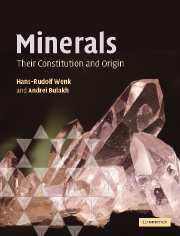Book contents
- Frontmatter
- Contents
- Preface
- Acknowledgments
- Figure credits
- Part I Structural features of minerals
- Part II Physical investigation of minerals
- Part III Variety of minerals and mineral-forming processes
- 14 Classification and names of minerals
- 15 Mineral identification of hand specimens
- 16 Mineral genesis
- 17 Stability of minerals. Principles of thermodynamics
- 18 Solid solutions
- Part IV A systematic look at mineral groups
- Part V Applied mineralogy
- Appendices
- Glossary
- References
- Index
- Plate section
- References
18 - Solid solutions
from Part III - Variety of minerals and mineral-forming processes
- Frontmatter
- Contents
- Preface
- Acknowledgments
- Figure credits
- Part I Structural features of minerals
- Part II Physical investigation of minerals
- Part III Variety of minerals and mineral-forming processes
- 14 Classification and names of minerals
- 15 Mineral identification of hand specimens
- 16 Mineral genesis
- 17 Stability of minerals. Principles of thermodynamics
- 18 Solid solutions
- Part IV A systematic look at mineral groups
- Part V Applied mineralogy
- Appendices
- Glossary
- References
- Index
- Plate section
- References
Summary
Crystallization of solid solutions from a melt
In Chapter 17 we explored phase diagrams and stability relations in systems with different minerals of well-defined compositions. In this chapter we will discuss some aspects of solid solutions, where compositions are variable. The first issue is the melting and crystallization behavior.
Solid solutions have a peculiar melting behavior. For example, in the olivine system (Fe2SiO4-Mg2SiO4), which is an example of a disordered and homogeneous solid solution, fayalite (Fe2SiO4) has a melting point that is over 685 ℃ lower than that of forsterite (Mg2SiO4) (Figure 18.1).
When a melt of composition 50% Fe2SiO4–50% Mg2SiO4 (X) cools to temperature T1 (on the upper curve, which corresponds to the liquidus), crystallization begins. The composition of the olivine crystal is given by the lower curve (the solidus) at the point x1. Since the crystal is enriched in magnesium (80% Mg2SiO4, 20% Fe2SiO4), the remaining melt becomes enriched in iron. Upon further cooling the composition of the melt changes along the liquidus and that of the crystal along the solidus (from point x1 to point x3). In this phase diagram there is melt above the liquidus, melt and crystal at conditions between the liquidus and solidus, and only crystal below the solidus. Using some thermodynamic arguments we can analytically derive this rather complicated diagram; an example of such a derivation is illustrated for another important system, plagioclase feldspar, in Box 18.1.
- Type
- Chapter
- Information
- MineralsTheir Constitution and Origin, pp. 305 - 310Publisher: Cambridge University PressPrint publication year: 2004



